How to define and implement guidelines for high-engagement content & why that’s so important
The days of viewing follower numbers as an accurate representation of an Instagram account’s value are slowly but surely coming to an end.

What’s the point of having 100,000 followers if only 5% of them view the content and only 1% or less of them care enough about it to engage with it?
In the future, the metric that marketers will care about when deciding who to pay and partner with on Instagram, as well as the metric Instagram small business owners will look at when evaluating how likely their audience is to buy something, will be average organic engagement.
Why this metric? Follower numbers are easy to manipulate and a terrible indicator of the value an account is creating. In comparison, the number of organic likes your posts get is the most accurate (and measurable) representation of how many followers are connected enough to content to engage and take further action because of it.
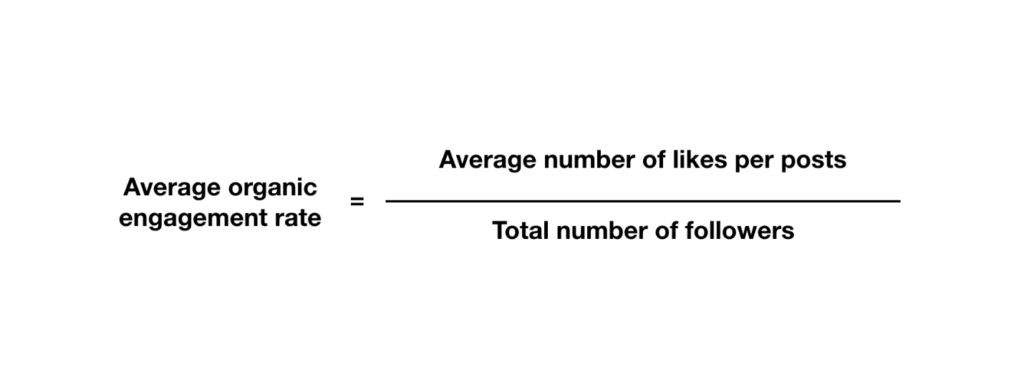
You measure your average organic engagement by calculating your average number of likes per post over the past month (total number of likes divided by the total number of posts over the past month) and divide that by your total number of followers.
The higher your engagement is in relation to your followers, the more likely they are to take action instead of simply clicking like. In other words, the larger the percentage of your followers who see, pay attention to, and connect with your posts, the greater the probability they will buy/follow/donate/ when you ask them to.
So if you’re building a business on Instagram where your success depends on your followers taking action (buying something or clicking on a link), it’s important that you pay attention to your organic engagement.
I wish I could show you some hacks to dramatically improve your engagement in a way that’ll grow your business. But the truth is, there are no hacks for this one.
Hacking your organic engagement growth through tactics like hash tagging, photo-tagging, comment pods, buying likes/comments, are not sustainable solutions. Even obsessively using the latest Instagram features (like using the countdown clock in stories or a feature as ubiquitous as video) just because it gets more engagement and not because it’s the best format for your content does not ensure long-term high organic engagement. Some of these tactics might also get you shadow banned.
Sadly for most of us, Instagram will continue to get better at identifying and limiting engagement manipulation techniques like Instagram bots. Their algorithm will change, new content creators similar to you will arise, people’s tastes will change, and your engagement and growth will likely decrease over time. Here’s an in-depth article to understand why your Instagram account isn’t growing. Instagram is now a highly competitive market and the days of being able to continuously manipulate your engagement and get away with it are over.
The only way to create high-quantity, long-lasting value through Instagram is by creating content that’s good enough to generate high levels of organic engagement over a long period of time. And the only way to do that is to clearly understand what content your audience deeply connects with, learn how to expertly execute that type of content at a high level, and, most importantly, continually measure how your audience’s preferences change so you can regularly optimize the content you create.
Although there are no shortcuts, there are simple systems that’ll help increase your chances of making a significant change in your engagement over time. Here’s how mine works:
1. Evaluate which posts generate the highest engagement on your account
The first step toward increasing your engagement is setting the high-engagement bar for yourself by understanding which content is already generating high engagement on Instagram.
Start by getting to know your audience. You can do that by identifying the most highly-engaged posts on your account through your Instagram Insights data.
Go to your Instagram Insights dashboard → Tap on the Feed Posts ‘See All’ text within your Content tab → Tap on the text at the top and sort by All/Engagement/1 year → Apply.
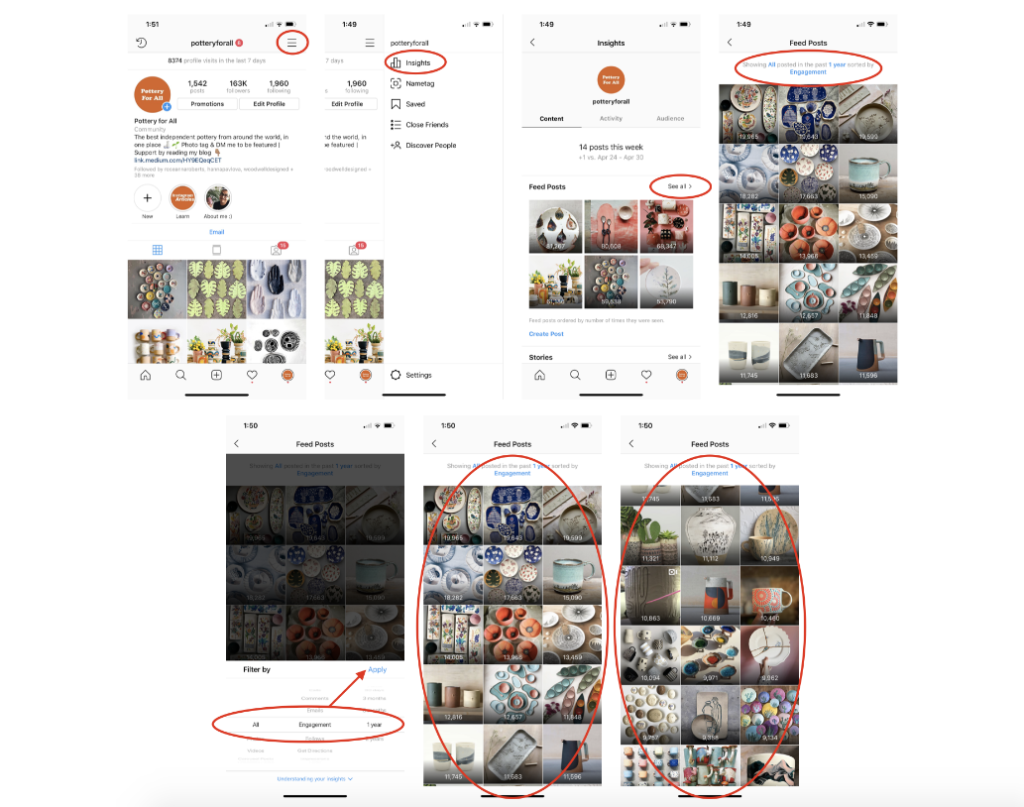
This is how you find the most highly-engaged posts on your account. Btw, you need an Instagram Business profile to do it, and it’s worth it.
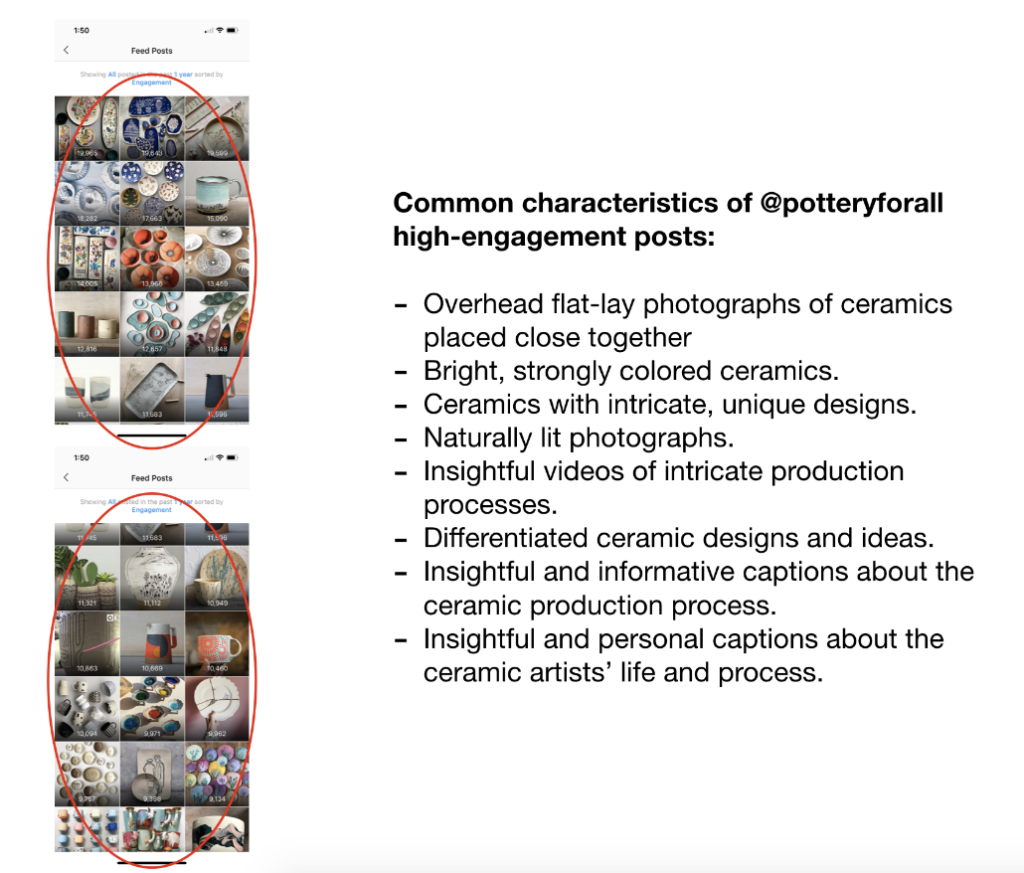
The first 30 posts in this screen are your most highly-engaged posts within the past year. These are the posts that created the most value for your audience. Ask yourself, what common characteristics do these posts share? Do they feature a particular style of photography or video? What are the posts about and how are the captions communicating this? How are they lit? What words are being used? Is there a unifying essence in all or groups of them? Write down your answers to these common characteristic questions.
I hear a lot of people saying “I create great content but no one likes it.” When it comes to building a business on Instagram, it’s important that we try to take our subjective opinion out of the process. It doesn’t matter if we think a photo is great…if no one sees or likes it, regardless of what we think of the photo, it won’t have an impact in our bottom line. What we want to create are posts that we are proud of AND that people love to see and engage with.
If, after analyzing your data, you don’t find any common characteristics, then you might have an issue. You either haven’t posted enough content to generate insightful data, you don’t have an audience large enough to give you insightful data (you’ll likely need at least 1K followers and 500 posts to generate insightful data), or you aren’t looking closely enough. Each account is different, but there are always common characteristics of high-engagement posts for all our accounts.
2. Evaluate which posts generate the highest engagement on Instagram
Once you’ve identified the common characteristics of high-engagement posts on your account, it’s important to also identify the common characteristics of high-engagement posts in the Instagram community in general.
Of course, you’ll never be able to perfectly understand which posts generate the highest engagement on Instagram because you don’t have access to that data. But, you can get a relatively good idea of what is getting high-engagement within your immediate community and within your content niche by analyzing the Explore page and the top feed posts in the most relevant hashtags within your niche.
The Explore page is where Instagram surfaces the highest engagement posts of the people that you follow, as well as general high-engagement posts within the Instagram community. The top feed section of a hashtag is reserved exclusively for the most highly engaged posts tagged with that hashtag.
To analyze the Explore page, simply go to that tab in the app, scroll through it thoroughly and frequently — the Explore page changes several times a day. Ask yourself the same questions that you asked when you analyzed your most highly engaged posts. What common characteristics do these posts share? Do they feature a particular style of photography or video? What are the posts about, and how are the captions communicating this? How are they lit? What words are being used?
Do the same analysis by scrolling thoroughly and frequently in the top feed section of the most relevant hashtags within your niche.
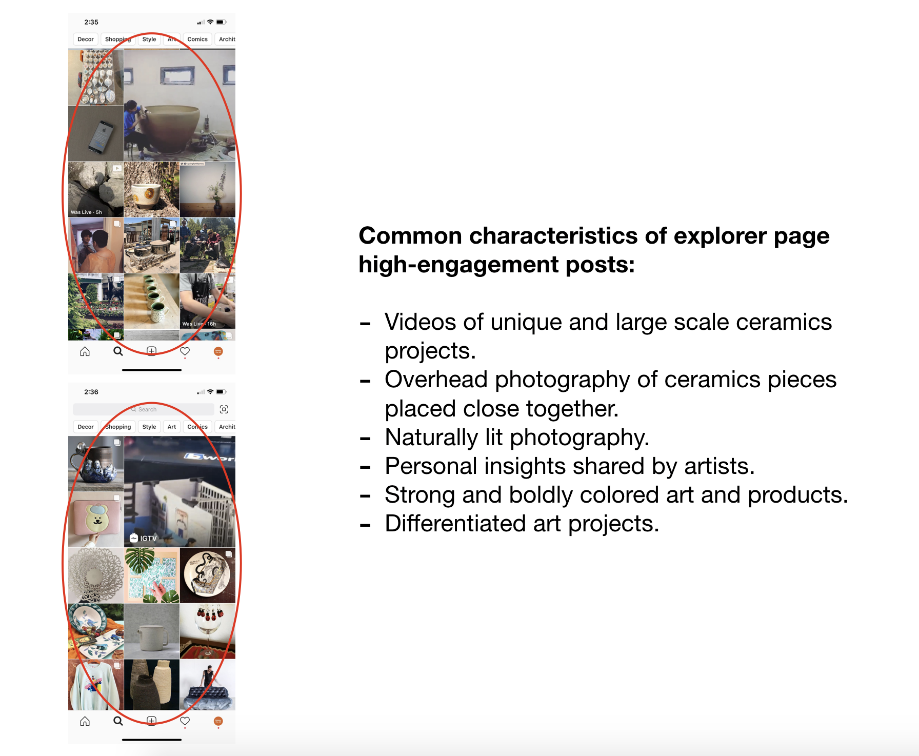
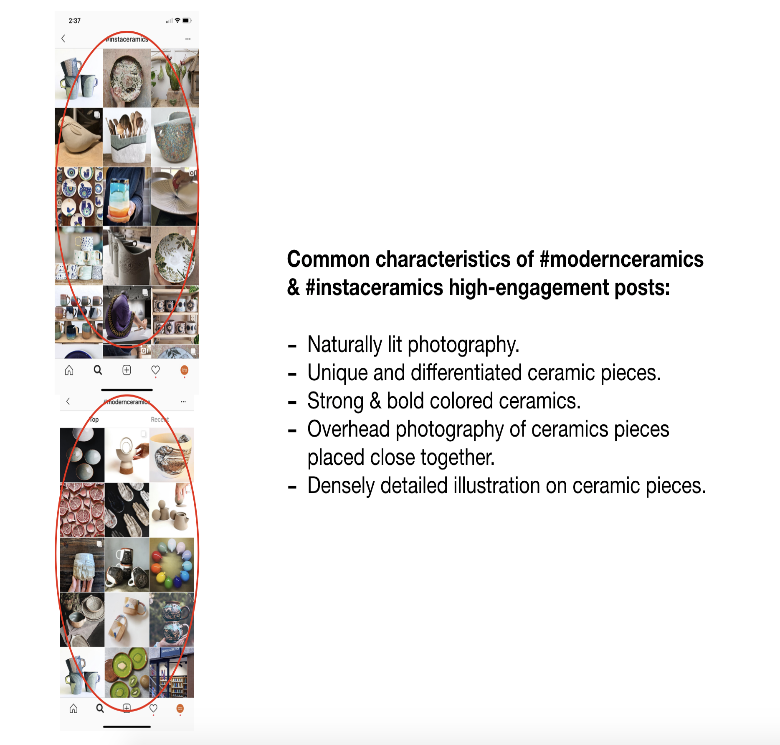
This is an example of the common characteristics I found when analyzing the most highly engaged-with posts in the Explore page as well as the #modernceramics & #instaceramics hashtags found through my account @digitalvasu
Make a list of the common characteristics that you found on the Explore page as well as in the hashtag posts and add them to the list of common characteristics of the most highly engaged posts in your account. This set of common characteristics will now become the content creation guidelines you’ll use when creating content in the future! By having a clear understanding of what generates high-engagement in your audience as well as the Instagram community in general, you now have a clear blueprint of what characteristics the content you create needs to have.
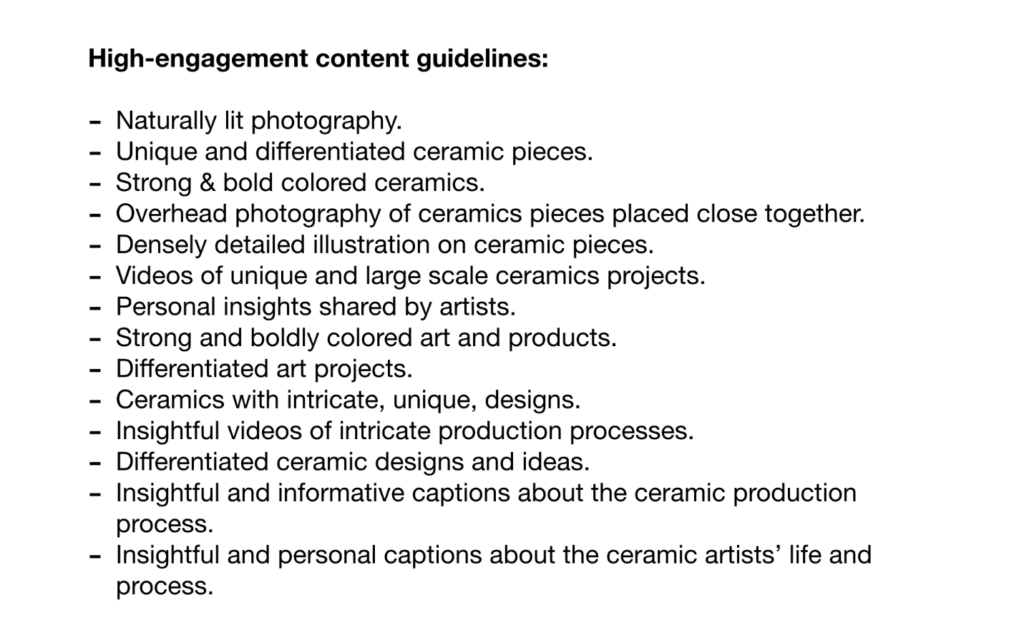
This is a list of the common characteristics high-engagement posts shared across my account @digitalvasu , the Explore page, and the most relevant hashtags. If I want to create high-engagement content, these are the guidelines I should follow.
3. Tweak your content creation process to execute the high-engagement guidelines you’ve identified
OK, you’ve now identified your high-engagement content guidelines, but knowing what is likely to generate high-engagement is only half the job. How will you consistently execute high-quality content that shares these characteristics over a long period of time?
A great place to start is by tweaking your content creation process to accommodate the changes needed. Let’s say you found that high-engagement content tends to have top-notch, naturally lit photography — do you have the skills, knowledge, and equipment to realistically one day be able to execute that on your own? What if you found that high-engagement content tends to tell personal stories about aspects of life that an audience is interested in — are you looking at the captions you write through that lens? If not, what changes can you introduce to your content creation process to facilitate that?
You won’t become a world-class Instagram photographer or story-teller overnight, but if you have clear objectives regarding what elements of your content you need to improve, and you work hard at making the changes needed to reach them, you WILL improve.
Maybe you don’t have the resources, time or interest in developing certain content creation skills (like photography). Can you hire or trade skills with someone who does? What changes are needed and how to change them will be unique to you and they will take time, but you should know that it’s the most essential part of the process. You can’t expect to see serious improvements to your engagement without making serious (and/or smart) changes to your content.
4. Plan and create new high-engagement content every week
You’ve identified your high-engagement guidelines, you’ve made the changes to your content creation process, and now you’re ready to start creating new content with the goal of increasing your engagement.
To do this, I recommend that on the same day every week you plan your content strategy for the week ahead and bulk create it. This means that instead of having to shoot and write a new post every day of the week, you plan, shoot and write all of your posts in one day per week. Once you have 7 days worth of content on file, you can just schedule and automate your posts for the week, ahead of time.
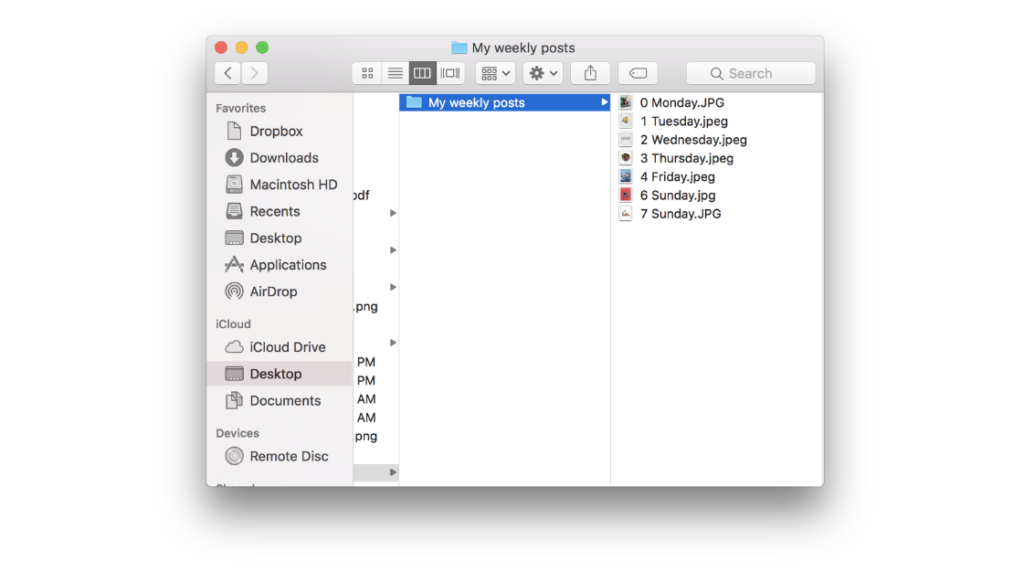
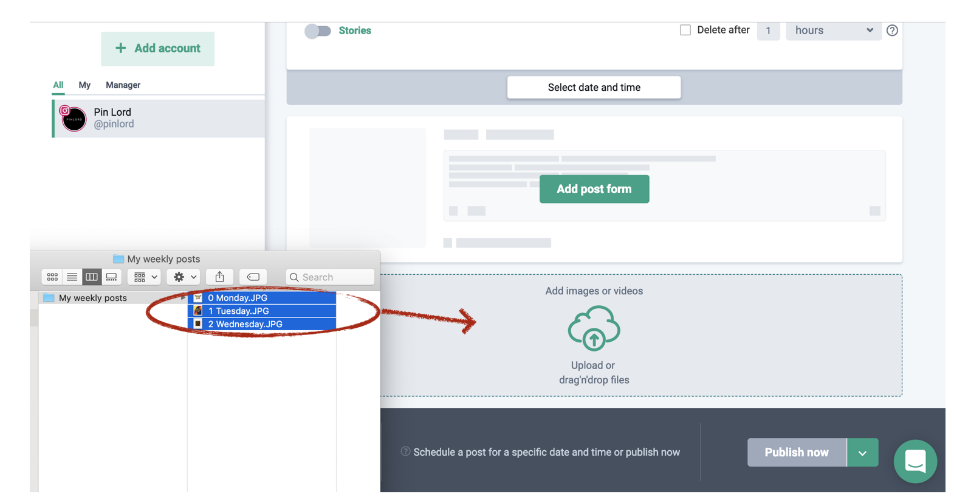
I create all of my content on Mondays and I use Onlypult.com to automate posts for the rest of the week in just a couple of hours. I prefer this service over the other options on the market because it’s the only one that allows you to include your hashtags in the first comment (and personally, I don’t like seeing hashtags in the caption). Here’s a guide of how I automate my Instagram posts.
This will not only save you time, but it’ll also help you streamline the process so you get better and more efficient at creating high-engagement content over time. Executing excellent content is more realistic when you don’t have to rush to create something quickly just because you didn’t plan your day properly.
5. Respond to every comment and DM
I’m sure you’ve heard this one before, but when it comes to increasing your engagement, responding to every comment and DM truly does matter. It doesn’t have to take long. Just set aside 5 minutes every single day to check your latest posts and respond to every single comment in it. It doesn’t have to be long and thoughtful messages (although that helps). A simple heart emoji is enough.
What you’re accomplishing by doing this is first, increasing the number of interactions in each post (if you get 5 comments, by responding to all of them, you’ll be doubling that amount. that’s double the content engagement), and second, building a stronger bond with your audience. We’ve all experienced it. If there is an Instagram account you love and frequently comment on, receiving a response to each one of your comments builds a stronger bond between you and that account. By making sure we respond to all comments, we are cementing our relationship with the people who care about your account the most.
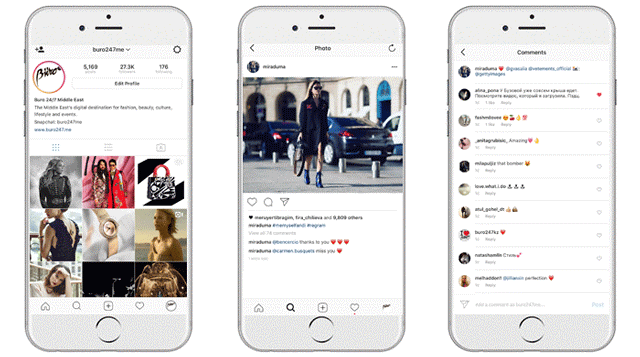
6. Measure how your content is performing through a spreadsheet
On the same day that you plan and create your content, measure the average engagement of last week’s posts and write that number down in a spreadsheet. Measure average Instagram engagement for the past week by adding up the total likes from all your posts that week and divide by the number of posts. Then, divide by your total number of followers and multiply by 100. This number is your average engagement rate.
In this spreadsheet, also track the change in average engagement from week to week, and the non-content variables that could have influenced it. For the non-content variables, I recommend measuring the number of posts per day. At first, aim to post at the same amount of posts every day each week. Also take note of the time of post. At first, aim to post at the same time every day each week. Next, check if you responded to all comments every day. Aim to respond to all comments — it’s the single most effective way to increase your likelihood of being favored by the Instagram Algorithm. Finally, keep a notes section in which you write a quick few sentences about the type of content you posted and what elements you consider helped increase or decrease the average engagement in comparison to the previous week.

Here’s an example of how I build my spreadsheet.
7. Use the data to optimize all elements of your content for maximum engagement
Why the hell keep track of engagement and these particular activities every week? By measuring how much engagement your content generated the past week and taking notes on the reasons why it increased or decreased in comparison to previous weeks, you are creating a system that help you understand how and why your activities impact your engagement.
By measuring the other variables, like your number of posts per day or what time you post them and if you responded to all of the comments, you are also tracking your performance in the three activities that influence engagement the most besides the content itself. By keeping track of them you are forcing yourself to pay attention, as well as increasing your likelihood of executing and optimizing them over time.
For example, let’s say for one week you post once a day at 9am and the next week once a day at 8pm. If the quality of your content is relatively similar for both weeks, any significant change in engagement might likely come from another variable, like the time of post.
By measuring what changes in engagement came from posting at one time vs. another time, you can figure out the time of day in which a post is more likely to generate the most engagement. You can use the same process to find the optimal times per day to post, but remember to keep all other variables the same and only change the number of posts per day from week to week.
This is how I track the change in my engagement and the corresponding changes in content and activities. In the week of 04/22/18 the data shows that I maximized engagement and growth at 2 posts per day, not 3. I also maximized engagement by posting at 8pm, not 9am. This continually changes, but by tracking it I’m able to identify changes quickly and make the corresponding changes, then continue testing.
By measuring all of these elements you’ll no longer be guessing what leads to more engagement. The data will tell you. The goal here is to use the spreadsheet as an anchor that will force you to objectively measure, analyze, and optimize your content for engagement from week to week. This system over time will lead to small improvements in your content and engagement, which adds up to noticeable changes in the long run.
8. Repeat the process and introduce content tests every week
You know what generates high engagement, you’re planning and creating your new content tailored to those guidelines every week, you’re executing all of the important engagement-increasing activities, and you’re measuring and optimizing every element every week. Now what?
All that’s left is to continue this process, continue to improve based on the data, and begin to introduce content tests every week. Content tests basically mean you start to post new, out-of-the-box content that you’ve never tried before and measure how it performs, engagement-wise. Post your regular content, but test new, out-of-the-box content once a week and measure its engagement. If it gets high-engagement, continue posting it the future. If it doesn’t, just try something different next week and measure again. The goal here is to introduce these new types of content to test how your audience’s tastes are changing and if there are any new content types that your audience connects with.
For example, one of the content tests I tried a few months back was posting a video of my wife and me dancing with a caption announcing that I had published a new article and that people could read it through my link in bio. I had never posted anything like this on @potteryforall previously so it was definitely out of the blue, but surprisingly enough, people liked it (it generated over 22K views) so I now post a similar video every time I release it an article.
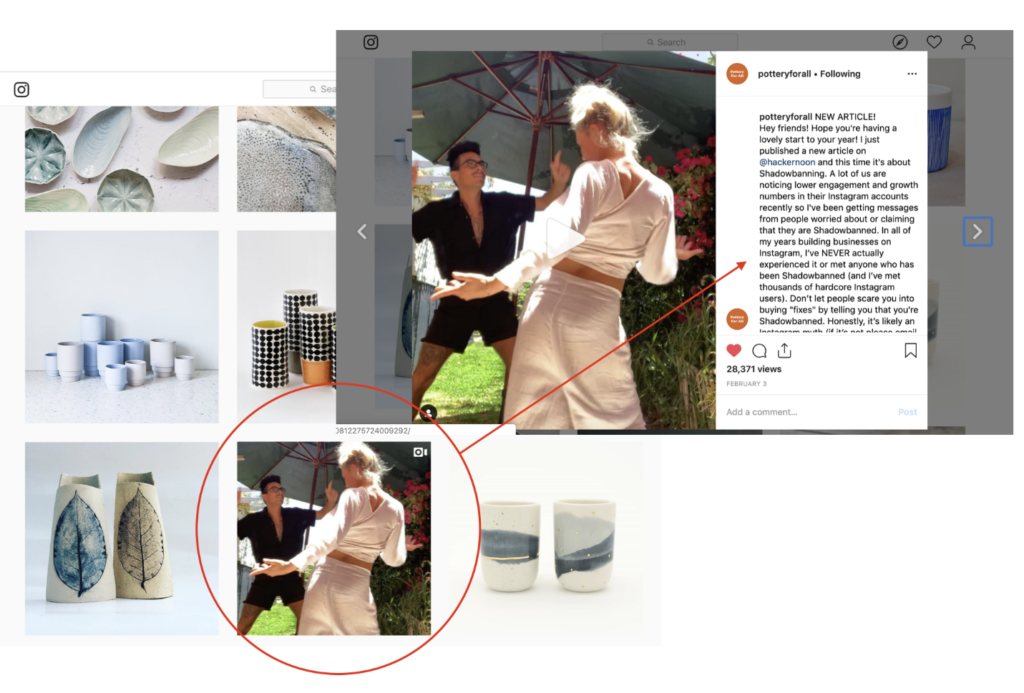
There’s such a thing as content fatigue. We’ve all experienced it. We discover a new Instagram account, love their content, so we follow them. If they keep posting about the same stuff, after a few months most of us will eventually be bored and stop following that account. Like any business, the future of an Instagram account also depends on being able to change and improve upon what you already do. These content tests will help you keep things fresh and find the type of content that your audience will love in the future!
And that’s it! 7 steps to increasing your Instagram engagement.
Let’s Summarize
Identify the common characteristics of the content that your audience loves and engages with the most → identify the common characteristics of what content people on Instagram love and engage with the most → create content guidelines out of those common characteristics → tweak your content creation process in order to be able to execute those guidelines → plan and create new content based on those guidelines every week → measure how your content is performing through a spreadsheet that tracks your average weekly engagement and the execution of the highest-impact engagement-increasing activities from week to week → use the data to optimize all elements of your content for maximum engagement → repeat the process and introduce content tests every week → rinse and repeat.
I never said it was easy, but focusing on a content-optimizing approach to your engagement is the only way to sustainably create a valuable, long-lasting Instagram account that makes money.
Best of all, once you have your Instagram engagement down, all other Instagram business growth tactics are much more likely to perform well too. And don’t worry, like anything else it’ll take time to master engagement growth. Just begin, and the process will give you the information to know where to head to next.
By the way, if you want to learn more about how Instagram works, read these articles on how the Instagram algorithm works, how to make money on Instagram, why your Instagram account isn’t growing, how to create effective Instagram story ads, how to create a visually appealing Instagram grid, how to increase your Instagram engagement, how to create effective Instagram sponsored posts, how to check if you’re shadow banned, how to create an Instagram repost account that makes money, how to monetize your Medium article, the best Instagram bots, how to automate an Instagram bot that isn’t spammy, how to increase your Instagram engagement rate, how to find the best times to post, as well as how to find the most valuable Instagram influencers, how to measure what an influencer is worth, how to measure your influencer marketing ROI, and how to reach out to influencers.
Thanks so much for taking the time to read my article! If you enjoyed reading it, you can support me by giving this article a bunch of claps, reading my other Instagram-related articles, and signing up for my newsletter to get updates whenever I publish a new piece. Thanks for reading ❤





